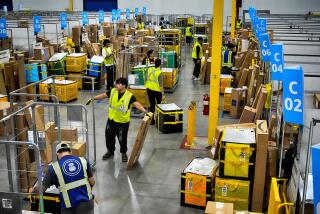Leading Indicators Up by 1.2% in November
WASHINGTON — The Commerce Department said Tuesday the government’s main index of future economic activity jumped 1.2% in November, the biggest increase in seven months.
Private economists, however, were divided over whether the surprisingly strong advance in the index of leading indicators was a true signal of a rebounding economy or an overstatement of growth prospects for next year.
The advance was more than double the 0.5% October rise in the leading index--a compilation of various forward-pointing economic statistics designed to predict economic activity six to nine months in the future.
Some analysts cautioned against reading too much into the November gain, contending it was more a reflection of short-term economic activity than a sign of future strength.
“I think this is an overly optimistic view of what we can expect the economy to do,” said Cynthia Latta, an economist with Data Resources Inc. of Lexington, Mass. “I think we will see moderate, steady growth. But this number would suggest a boom period, and we are not going to get that.”
Latta estimated the economy, as measured by the gross national product, was expanding at a 3.5% annual rate as 1986 ended, but she said this would weaken to a 1% rate in the first three months of 1987.
Tax Overhaul Cited
She said the faster growth in the final three months of this year and the big drop next year were attributable to the massive overhaul of the tax law that takes effect on Jan. 1. To take advantage of expiring tax benefits, businesses and consumers accelerated purchases this quarter but will cut back on spending in the first three months of next year, Latta and other economists say.
But Doug Handler, an economist at Wharton Econometrics, another private forecasting firm, argued that the effect of the tax law has been overstated. He predicted 1987 will show steadily improving growth throughout the year, just as the leading index is suggesting.
“We have had three consecutive months of positive increases in the index. Given this trend, we should have good growth next year,” he said. “And if we get more reports like today’s rise, then 1987 could turn out to be a fantastic year.”
In other economic news Tuesday, the Commerce Department said sales of new homes slid further in November, dropping to an annual rate of 661,000 units, 2.2% below the October figure. It was the seventh decline in the past eight months and showed, analysts said, that the impact of falling mortgage rates was being outweighed by price increases for new homes. The average price of a new home shot up 3.8% in November to $116,800.
The November increase in the leading index was the biggest advance since a another 1.2% rise last April. The biggest positive contribution last month came from a jump in raw materials prices, especially in price increases for lumber, iron and steel, aluminum and cattle hides.
Biggest Contributors
In all, eight of the 11 economic barometers showed strength last month. The biggest contributors--in descending order of importance--were a rise in raw materials prices, a rise in stock market prices, growth in the length of the work week, a jump in orders for business equipment, a rise in building permits and growth in the money supply. Also providing strength were a change in delivery times on business orders and a drop in initial unemployment claims.
More to Read
Inside the business of entertainment
The Wide Shot brings you news, analysis and insights on everything from streaming wars to production — and what it all means for the future.
You may occasionally receive promotional content from the Los Angeles Times.










